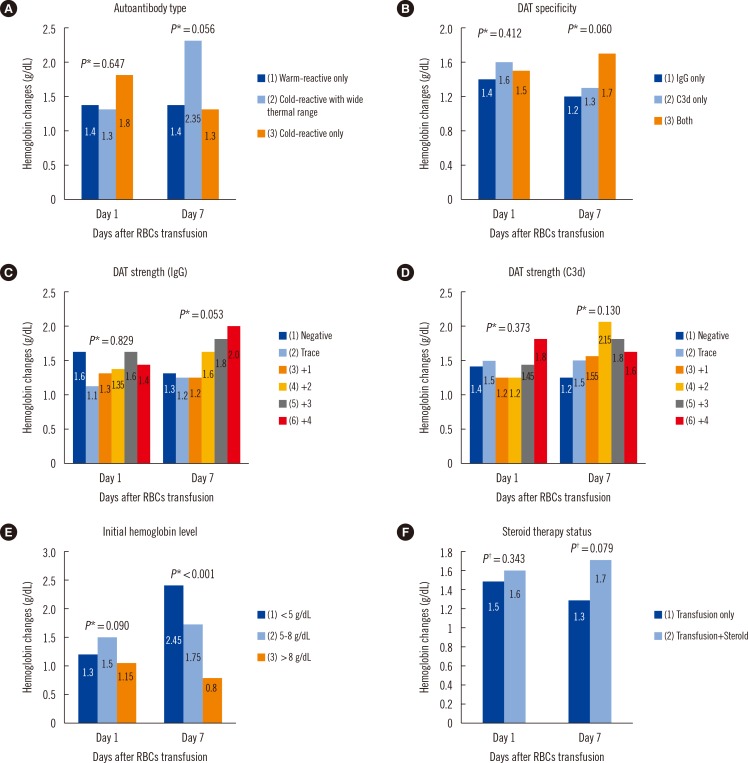Ann Lab Med.
2015 Jul;35(4):436-444. 10.3343/alm.2015.35.4.436.
Red Blood Cell Transfusion in Patients With Autoantibodies: Is It Effective and Safe Without Increasing Hemolysis Risk?
- Affiliations
-
- 1Department of Laboratory Medicine, Pusan National University School of Medicine, Pusan National University Hospital, Busan, Korea.
- 2Biomedical Research Institute, Pusan National University Hospital, Busan, Korea.
- 3Department of Laboratory Medicine, Eulji Medical Center, Eulji University School of Medicine, Seoul, Korea.
- 4Department of Laboratory Medicine, University of Ulsan College of Medicine and Asan Medical Center, Seoul, Korea. swkwon@amc.seoul.kr
- KMID: 2045867
- DOI: http://doi.org/10.3343/alm.2015.35.4.436
Abstract
- BACKGROUND
The therapeutic efficacy of red blood cell (RBC) transfusions in patients with autoimmune hemolytic anemia (AIHA) is highly debated because of speculations on the increased risk of transfusion reactions; yet it is a suggested adjuvant therapy in anemic patients with life-threatening hypoxemia. In this study, we evaluated the safety and efficacy of RBC transfusions in AIHA patients.
METHODS
Daily changes in hemoglobin, total bilirubin, and lactate dehydrogenase (LDH) were assessed in 161 AIHA patients without bleeding history who were transfused once with 1-5 units of the least-incompatible RBCs and monitored over a seven-day period. Post-transfusion patients positive for alloantibodies only or those without RBC-specific antibodies were considered as control groups (N=100 for both groups).
RESULTS
The three groups revealed similar increases in hemoglobin of 1.40-1.70 g/dL (autoantibodies), 1.20-1.60 g/dL (alloantibodies only), and 1.40-1.55 g/dL (no antibodies) for seven days following transfusion of 10 mL RBCs/kg. During follow-up, no significant changes in total bilirubin or LDH levels were detected in the AIHA group compared with controls. Influences due to autoantibody type, direct antiglobulin test (DAT) specificity and strength, and steroid therapy status on transfusion reactions were not evident in AIHA patients. In addition, changes in hemoglobin levels were significantly higher (P<0.001) in severe anemia (<5 g/dL) than in other patients.
CONCLUSIONS
Transfusion of the least-incompatible RBCs in AIHA patients is effective and safe without any associated increase in hemolysis risk when compared with post-transfusion patients positive for alloantibodies or those lacking RBC-specific antibodies.
Keyword
MeSH Terms
Figure
Cited by 2 articles
-
Diagnosis and treatment of autoimmune hemolytic anemia: classic approach and recent advances
Sang Hyuk Park
Blood Res. 2016;51(2):69-71. doi: 10.5045/br.2016.51.2.69.Pre-transfusion Testing Using Crossmatching Agglutination Reaction Grades Combined With Rh Subgroup Phenotyping in Patients With Autoantibodies: A Three-year Experience at a Tertiary Hospital
Jongmin Kim, Kyung-Hwa Shin, Hyerim Kim, Hyung-Hoi Kim, Hyun-Ji Lee
Ann Lab Med. 2023;43(5):470-476. doi: 10.3343/alm.2023.43.5.470.
Reference
-
1. Packman CH. Hemolytic anemia due to warm autoantibodies. Blood Rev. 2008; 22:17–31. PMID: 17904259.
Article2. Barros MM, Blajchman MA, Bordin JO. Warm autoimmune hemolytic anemia: recent progress in understanding the immunobiology and the treatment. Transfus Med Rev. 2010; 24:195–210. PMID: 20656187.
Article4. Reardon JE, Marques MB. Laboratory evaluation and transfusion support of patients with autoimmune hemolytic anemia. Am J Clin Pathol. 2006; 125(S):S71–S77. PMID: 16830958.
Article5. Wheeler CA, Calhoun L, Blackall DP. Warm reactive autoantibodies: clinical and serologic correlations. Am J Clin Pathol. 2004; 122:680–685. PMID: 15491963.6. Roback JD, Combs MR, editors. Technical manual. 16th ed. Bethesda: American Association of Blood Banks;2008. p. 511.7. Hillyer CD, Silberstein LE, editors. Blood banking and transfusion medicine. 2nd ed. Philadelphia: Elsevier;2007. p. 560–561.8. Salama A, Berghöfer H, Mueller-Eckhardt C. Red blood cell transfusion in warm-type autoimmune haemolytic anaemia. Lancet. 1992; 340:1515–1517. PMID: 1361607.
Article9. Petz LD. A physician's guide to transfusion in autoimmune haemolytic anaemia. Br J Haematol. 2004; 124:712–716. PMID: 15009058.
Article10. Leger RM, Garratty G. Evaluation of methods for detecting alloantibodies underlying warm autoantibodies. Transfusion. 1999; 39:11–16. PMID: 9920161.
Article11. King KE, Ness PM. Treatment of autoimmune hemolytic anemia. Semin Hematol. 2005; 42:131–136. PMID: 16041662.
Article12. Viele MK, Weiskopf RB. What can we learn about the need for transfusion from patients who refuse blood? The experience with Jehovah's Witnesses. Transfusion. 1994; 34:396–401. PMID: 8191563.
Article13. Wikman A, Axdorph U, Gryfelt G, Gustafsson L, Björkholm M, Lundahl J. Characterization of red cell autoantibodies in consecutive DAT-positive patients with relation to in vivo haemolysis. Ann Hematol. 2005; 84:150–158. PMID: 15551098.
Article
- Full Text Links
- Actions
-
Cited
- CITED
-
- Close
- Share
- Similar articles
-
- Red Blood Cell Transfusion in Autoimmune Hemolytic Anemia
- A case of autoimmune hemolytic anemia due to autoanti-Ce
- A Clinical Study on Hemolysis during Transfusian of Bank Blood
- Acute Hemolysis Caused by Transfusion of Overheated Blood: A case report
- Hemoglobinuria due to the Use of Frozen Red Blood Cells during Anesthesia


